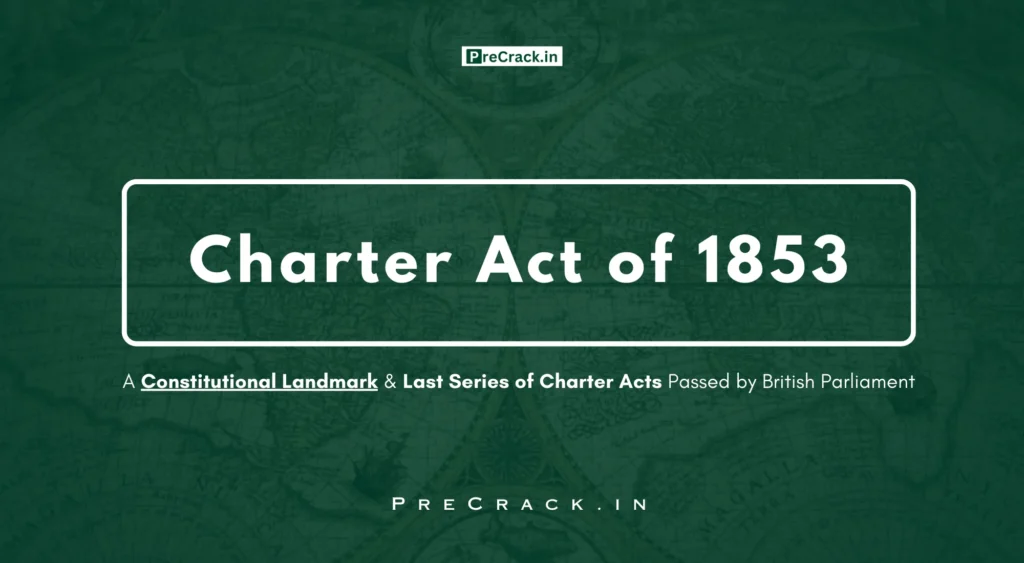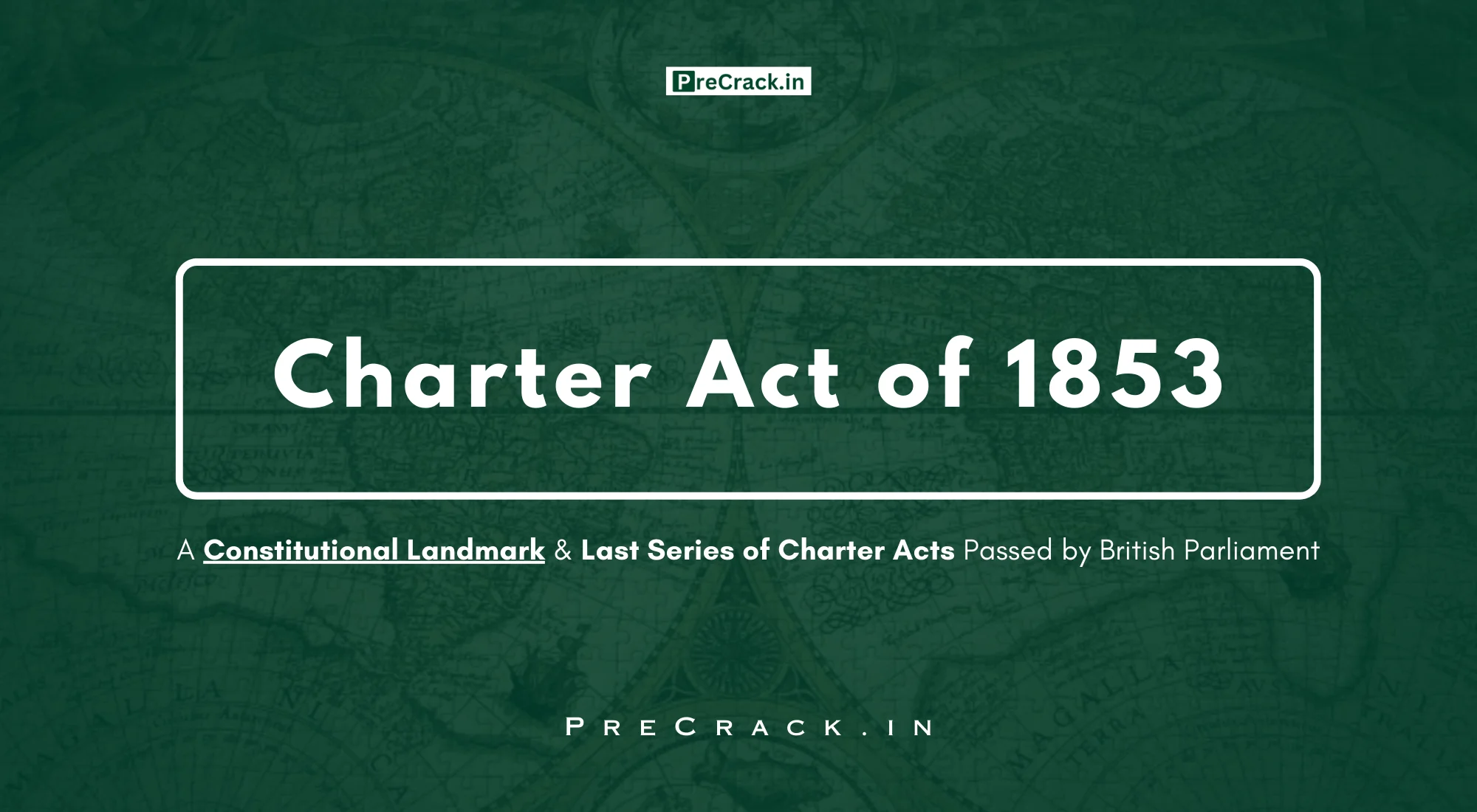The Charter Act of 1853 – Indian Polity
Table of Contents
What is the Charter Act of 1853?
It was the last act of the series of charter acts. The Charter Act of 1853 separated the legislative and executive functions in India & introduced open competition for civil service. It also has extended the Company rule, and allowed local representation in the legislative council.

Read Also | The Charter Act of 1833?
Objective of Charter act of 1853
The Objectives of Charter Act of 1853 was:
- Separation of Powers: To separate the legislative and executive functions within the Governor-General’s council, establishing a distinct legislative council.
- Civil Service Reform: To introduce an open competition system for the selection and recruitment of civil servants, thereby allowing Indian participation in the covenanted civil service.
- Extension of Company Rule: To extend the East India Company’s rule in India and allow it to retain control over Indian territories on behalf of the British Crown.
- Flexibility in Rule Duration: Unlike previous charter acts, the Act did not specify a fixed period for the Company’s rule, indicating the potential for its termination at the discretion of the British Parliament.
- Introduction of Local Representation: To introduce local representation within the legislative council, enabling the nomination of legislative members by provincial governments.
- Adoption of Parliamentary Procedures: To adopt parliamentary procedures within the legislative council, treating legislation as a specialized governmental function.
Features of Charter Act of 1853
These were the features of Charter Act of 1853:
- Separation of Functions: Established a separate legislative council, distinct from the executive functions of the Governor-General’s council.
- Legislative Expansion: Added six legislative councillors, forming the Indian (Central) Legislative Council.
- Open Competition: Introduced open competition for civil service recruitment, allowing Indian participation.
- Extension of Company Rule: Extended the East India Company’s rule over Indian territories, without specifying a fixed period.
- Local Representation: Introduced local representation in the legislative council, with four members nominated by provincial governments.
- Parliamentary Procedures: Adopted parliamentary procedures within the legislative council, resembling those of the British Parliament.
- Macaulay Committee: Formed the Macaulay Committee to oversee civil service recruitment reforms.
- Trusteeship for the Crown: Permitted the Company to retain control over Indian territories on trust for the British Crown.
- Constitutional Significance: Marked a significant milestone in the constitutional evolution of British governance in India.
- Legislative Autonomy: Provided legislative autonomy within the council, enabling it to function as a mini-Parliament.
FAQs – Charter Act of 1853 UPSC Questions
1. What was the main objective of the Charter Act of 1853?
A) To abolish Company rule in India
B) To establish British monarchy in India
C) To separate legislative and executive functions
D) To grant independence to Indian provinces
2. Which of the following was NOT a feature of the Charter Act of 1853?
A) Introduction of open competition for civil service
B) Extension of Company rule with a fixed duration
C) Establishment of a separate legislative council
D) Introduction of local representation in the legislative council
3. What significant reform did the Charter Act of 1853 introduce in civil service recruitment?
A) Reservation for British citizens only
B) Abolition of civil service recruitment
C) Introduction of open competition
D) Hereditary appointment system
4. The Charter Act of 1853 allowed the East India Company to retain control over Indian territories on behalf of which entity?
A) United States
B) British Crown
C) French Monarchy
D) Indian Parliament
5. How did the Charter Act of 1853 impact the duration of Company rule in India?
A) It extended Company rule indefinitely
B) It specified a fixed duration for Company rule
C) It allowed for potential termination by the British Parliament
D) It transferred control to the Indian provinces
6. Which committee was appointed as a result of the Charter Act of 1853 to oversee civil service reforms?
A) Macaulay Committee
B) Gandhi Committee
C) Nehru Committee
D) Patel Committee
7. How did the Charter Act of 1853 affect the composition of the Governor-General’s council?
A) It reduced the number of council members
B) It abolished the council altogether
C) It added legislative councillors to separate legislative functions
D) It merged legislative and executive functions
8. Which of the following was NOT a result of introducing open competition for civil service recruitment?
A) Increased participation of Indians in civil service
B) Merit-based recruitment
C) Continued monopoly of British elite
D) Greater diversity in civil service
9. What role did local representation play in the legislative council established by the Charter Act of 1853?
A) All members were appointed by the British Parliament
B) All members were nominated by the Governor-General
C) Members were nominated by provincial governments
D) Members were elected by the general population
10. How did the Charter Act of 1853 contribute to the decentralization of governance in British India?
A) By centralizing power in the hands of the Governor-General
B) By abolishing local representation
C) By empowering provincial governments and introducing local representation
D) By establishing a unitary system of governance
Answer keys:
1. C) To separate legislative and executive functions
2. B) Extension of Company rule with a fixed duration
3. C) Introduction of open competition
4. B) British Crown
5. C) It allowed for potential termination by the British Parliament
6. A) Macaulay Committee
7. C) It added legislative councillors to separate legislative functions
8. C) Continued monopoly of British elite
9. C) Members were nominated by provincial governments
10. C) By empowering provincial governments and introducing local representation




One thought on “The Charter Act of 1853 – Indian Polity”
Comments are closed.